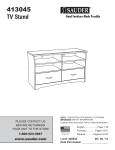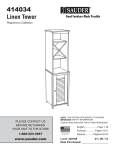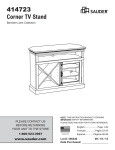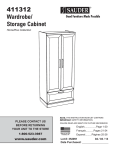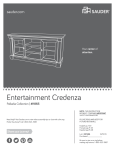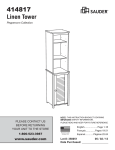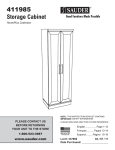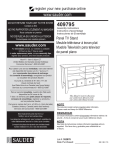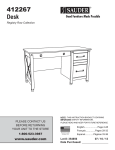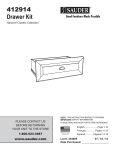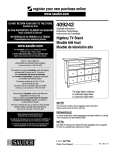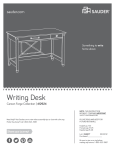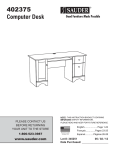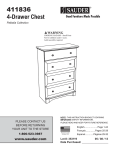Download 1 - Sears
Transcript
412312 Entertainment Credenza Registry Row Collection PLEASE CONTACT US BEFORE RETURNING YOUR UNIT TO THE STORE 1-800-523-3987 www.sauder.com NOTE: THIS INSTRUCTION BOOKLET CONTAINS IMPORTANT SAFETY INFORMATION. PLEASE READ AND KEEP FOR FUTURE REFERENCE. English .................... Page 2-27 Français ...............Pages 28-31 Made in the USA Archbold, OH Espanol.............Páginas 32-35 Lot #: 339224 07 / 12 / 11 Date Purchased: ____________________ TABLE OF CONTENTS ASSEMBLY TOOLS REQUIRED Part Identification .......................3 No. 2 Phillips Screwdriver Hardware Identification ......... 4-5 Tip Shown Actual Size Assembly Steps .................... 6-27 Français .............................. 28-31 Hammer Espanol............................... 32-35 Safety ................................. 36-38 Straight Edge Screwdriver Warranty ...................................39 WARNING Use of a TV that is too heavy or large is hazardous. A TV that is too heavy will create a risk of a tip-over that can cause severe injury or death. A TV that is too large for the available space might be accidentally pushed or bumped off the furniture, or subject to tip-over. • Check the size and weight of your TV. Compare it to the diagram below – before you begin assembly! • This Sauder unit is designed for use with televisions weighing less than 135 pounds. Never use with a TV that weighs more. • The size of the television, front-to-back and side-to-side, must fit within the space defined in the diagram. • Never place the front edge of the TV past the front edge of the TV support shelf (or stop molding – if equipped) • Never allow the sides of the TV to extend past the side edges of the TV support surface. • If the TV has a CRT picture tube, the picture tube cone may extend past the rear of the support shelf. • Be sure to apply the warning label as instructed in the last assembly step. The label provides important safety related information. 15-1/2" 60-3/4" 135 lbs. Page 2 www.sauder.com/services 412312 PART IDENTIFICATION: While not all parts are labeled, some of the parts will have a label or an inked letter on the edge to help distinguish similar parts from each other. Use this PART IDENTIFICATION to help identify similar parts. A RIGHT END 1 J SMALL BACK 1 R DRAWER FRONT 1 B LEFT END 1 K DOOR 2 S DRAWER BACK 1 C RIGHT UPRIGHT 1 L BACK 1 T DRAWER SIDE 2 D LEFT UPRIGHT 1 M ADJUSTABLE SHELF 4 U DRAWER BOTTOM 1 N SMALL ADJUSTABLE SHELF 1 V SKIRT 1 O LEFT FRONT LEG 1 W END MOLDING 4 P RIGHT FRONT LEG 1 X TOP MOLDING 1 Q REAR LEG 2 Y EXTENSION BLOCK 1 E TOP 1 F FLIP TOP 1 G BOTTOM 1 H SMALL BOTTOM 1 I SHELF 1 W E Q F A W C M L J D H M P X N I M W K M Q B W V G T K O S Y U T 412312 www.sauder.com/services R Page 3 HARDWARE IDENTIFICATION Z RIGHT CABINET RAIL - 1 CC LEFT DRAWER SLIDE - 1 GG ANGLE BRACKET - 5 KK CENTER FOOT - 1 OO BUMPER - 4 SS AA LEFT CABINET RAIL - 1 LL FOOT BASE - 1 PP PULL - 1 RUBBER SLEEVE - 20 EE CAM DOWEL - 25 DD HIDDEN CAM - 31 HH METAL BRACKET - 2 II FF DRAWER FRONT BRACKET - 1 MM FELT DISC CARD - 1 QQ GROMMET CAP - 2 TT METAL PIN - 20 BB RIGHT DRAWER SLIDE - 1 UU HINGE - 4 JJ CAM SCREW - 6 FOOT - 4 NN CORNER ACCENT - 2 RR GROMMET - 2 VV SW HINGE - 3 Screws are shown actual size. You may receive extra hardware with your unit. Page 4 www.sauder.com/services 412312 HARDWARE IDENTIFICATION WW KNOB - 2 XX BACKPLATE - 2 YY CORD CLIP - 4 ZZ WARNING LABEL - 1 WARNING Never use this furniture with a TV that is too large or too heavy. Severe injury or death can occur. The TV and furniture will be unstable and may tip. -The TV must less than 135 lbs. -The base of the TV must be able to sit completely on this shelf. -Refer to instruction book for complete safety information. Note: This is a permanent label. Do not try to remove. Surface will be damaged. 02/ 02 269232 269232 (Refer to the last step for proper location and application) AAA BLACK 2-1/4" FLAT HEAD SCREW - 6 BBB BLACK 1-7/8" FLAT HEAD SCREW - 7 CCC BROWN 1-5/8" FLAT HEAD SCREW - 4 DDD BLACK 1-1/8" MACHINE SCREW - 2 EEE SILVER 5/8" MACHINE SCREW - 2 FFF BLACK 9/16" FLAT HEAD SCREW - 8 GGG BLACK 9/16" LARGE HEAD SCREW - 18 III JJJ GOLD 5/16" FLAT HEAD SCREW - 8 LLL HHH SILVER 1/2" MACHINE SCREW - 2 BLACK 1/2" FLAT HEAD SCREW - 14 NAIL - 60 Screws are shown actual size. You may receive extra hardware with your unit. 412312 www.sauder.com/services Page 5 S p te Look for this icon. It means a video assembly tip is available at: www.sauder.com/services/tips 1 Do not tighten the HIDDEN CAMS in this step. Arrow EE I DD D Do not insert CAM DOWELS into these edges. Arrow C A B Insert the CAM DOWEL into the HIDDEN CAM. H J G Arrow Arrow DD (31 used) DD EE (25 used) EE Assemble your unit on a carpeted floor or on the empty carton to avoid scratching your unit or the floor. Push thirty-one HIDDEN CAMS (DD) into the ENDS (A and B), UPRIGHTS (C and D), BOTTOM (G), SMALL BOTTOM (H), SHELF (I), and SMALL BACK (J). Then, insert a CAM DOWEL (EE) into each HIDDEN CAM, except in the long edges of the ENDS (A and B). Page 6 www.sauder.com/services 412312 S p te 2 SILVER 5/8" MACHINE SCREW (2 used in this step) EEE FF NN P NN O FF Turn six CAM SCREWS (FF) into the FRONT LEGS (O and P). Fasten a CORNER ACCENT (NN) to each FRONT LEG (O and P). Use two SILVER 5/8" MACHINE SCREWS (EEE). 412312 www.sauder.com/services Page 7 S p te 3 Sur f fou ace w r ho ith les A Sur f HIDace w DE ith NC AM B S P Angled edge O Angled edge 1 2 Fasten the FRONT LEGS (O and P) to the ENDS (A and B). Tighten six HIDDEN CAMS Page 8 www.sauder.com/services 412312 S BLACK 2 1/4" FLAT HEAD SCREW (6 used in this step) p te 4 AAA W Q Angled edge W Apply pressure with your hands as you guide the MOLDINGS over the SCREWS and onto the END. A P W FFF BLACK 9/16" FLAT HEAD SCREW (8 used in this step) O Shoulder B W Q W Angled edge AAA Turn eight BLACK 9/16" FLAT HEAD SCREWS (FFF) into the ENDS (A and B) until the shoulder of the SCREWS rest on the surface of the ENDS. Slide the END MOLDINGS (W) onto the ENDS (A and B). Line up the groove in the MOLDING over the head of the SCREWS in the END and slide it until it is against the RIGHT FRONT LEGS (O and P). Fasten the RIGHT REAR LEGS (Q) to the ENDS (A and B). Use six BLACK 2 1/4" FLAT HEAD SCREWS (AAA). 412312 www.sauder.com/services Page 9 S p te 5 Roller end Curved edge 1 S H urf ID a c D e E w N it C h A M 2 3 C Z 4 S H urf ID a c D e E w N it C h A M Curved edge 4 3 D 2 AA 1 III GOLD 5/16" FLAT HEAD SCREW (4 used in this step) Roller end Fasten the CABINET RAILS (Z and AA) to the UPRIGHTS (C and D). Use four GOLD 5/16" FLAT HEAD SCREWS (III) through holes #1 and #4. NOTE: The CABINET RAILS are marked “CABINET RIGHT” and “CABINET LEFT” for easy identification. Page 10 www.sauder.com/services 412312 Caution Risk of damage or injury. Hidden Cams must be completely tightened. Hidden Cams that are not completely tightened will loosen, and parts may separate. To completely tighten: 1 2 Arrow Arrow 210 degrees Tightened properly Arrow S 180 degrees Not tightened! Caution Do not stand the unit upright without the BACK fastened. The unit may collapse. p te 6 Curved edge Finished edge D Curved edge I Su HIrface DD w EN ith CA M C Fasten the UPRIGHTS (C and D) to the SHELF (I). Tighten four HIDDEN CAMS. 412312 www.sauder.com/services Page 11 S p te 210 degrees 210 degrés 210 grados 7 Arrow Flèche Flecha B D C G A BBB BLACK 1-7/8" FLAT HEAD SCREW (4 used in this step) Fasten the UPRIGHTS (C and D) to the BOTTOM (G). Use four BLACK 1-7/8" FLAT HEAD SCREWS (BBB). Fasten the ENDS (A and B) to the BOTTOM (G). Tighten four HIDDEN CAMS. Use a STRAIGHT EDGE SCREWDRIVER. Page 12 www.sauder.com/services 412312 S p te 8 BLACK 1-7/8" FLAT HEAD SCREW (3 used in this step) BBB Edge with CAM DOWELS Su no rfa ho ce le wi s th J H RR QQ Fasten the SMALL BACK (J) to the SMALL BOTTOM (H). Use three 1-7/8" FLAT HEAD SCREWS (BBB). Push the GROMMETS (RR) and GROMMET CAPS (QQ) into the large holes in the SMALL BACK (J). 412312 www.sauder.com/services Page 13 S p te 9 H B Su HIrface DD w EN ith CA M S J A 210 degrees 210 degrés 210 grados Arrow Flèche Flecha Fasten the SMALL BACK (J) and SMALL BOTTOM (H) to the ENDS (A and B). Tighten four HIDDEN CAMS. Use a STRAIGHT EDGE SCREWDRIVER. Page 14 www.sauder.com/services 412312 S p te 10 YY B E D J C A 210 degrees 210 degrés 210 grados Arrow Flèche Flecha Push four CORD CLIPS (YY) into the holes in the TOP (E). Fasten the TOP (E) to the ENDS (A and B) UPRIGHTS (C and D), and SMALL BACK (J). Tighten nine HIDDEN CAMS. Use a STRAIGHT EDGE SCREWDRIVER. 412312 www.sauder.com/services Page 15 S p te 11 GG GGG BLACK 9/16" LARGE HEAD SCREW (10 used for the ANGLE BRACKETS) V GG GG B G A Fasten five ANGLE BRACKETS (GG) to the SKIRT (V). Use five BLACK 9/16" LARGE HEAD SCREWS (GGG). NOTE: Be sure the edges of the ANGLE BRACKETS are even with the edges of the SKIRT. Now, fasten the SKIRT to the ENDS (A and B) and BOTTOM (G). Use five BLACK 9/16" LARGE HEAD SCREWS (GGG). Page 16 www.sauder.com/services 412312 S p te 12 O (4 used) JJ JJ G Q P Q Turn your unit onto its top. Push a FOOT (JJ) over the bottom edge of each LEG (O, P and Q). 412312 www.sauder.com/services Page 17 S Caution Do not stand the unit upright without the BACK fastened. The unit may collapse. p te 13 These holes must be here. These holes must line up over the UPRIGHTS. LLL n U fi NAIL (60 used for the BACK) ni e sh d ce fa r su L G LL Y KK CCC BROWN 1-5/8” FLAT HEAD SCREW (4 used in this step) Carefully turn your unit over onto its front edges. Unfold the BACK (L) and lay it over your unit. Make equal margins along all the long edges of the BACK (L). Push on opposite corners of your unit if needed to make it “square”. Fasten the BACK (L) to your unit using the NAILS (LLL). NOTE: Be sure to tap NAILS into the holes that line up over the UPRIGHTS. NOTE: Perforations have been provided for access through the BACK. Carefully cut out the holes needed. Fasten the EXTENSION BLOCK (Y) and FOOT BASE (LL) to the BOTTOM (G). Use four BROWN 1-5/8" FLAT HEAD SCREWS (CCC). Push the CENTER FOOT (KK) into the FOOT BASE. Page 18 www.sauder.com/services 412312 S p te 14 OO VV SW is stamped into this hinge for identification. Adjusting screw (depth) F h pt de Mounting screw (vertical) VV l ta on riz ho (horizontal adjustment screws) JJJ F BLACK 1/2" FLAT HEAD SCREW (6 used in this step) vertical J Fasten the SW HINGES (VV) to the FLIP TOP (F). Use six BLACK 1/2" FLAT HEAD SCREWS (JJJ). Push four BUMPERS (OO) into the FLIP TOP (F). Fasten the FLIP TOP (F) to the SMALL BACK (J). Use the screws in the HINGES. Refer to the enlarged diagram to identify the parts on the SW HINGES. The FLIP TOP may need some adjustments. Follow the text below to make needed adjustments. FLIP TOP ADJUSTMENTS: To adjust the FLIP TOP in or out (depth), loosen the mounting screw several turns, then turn the adjusting screw in or out. Tighten the mounting screw after making adjustments. To adjust the FLIP TOP side to side (horizontal), loosen both horizontal adjustment screws. Move the FLIP TOP side to side so the edges are even with the TOP. Tighten the screws after making adjustments. To adjust the FLIP TOP up or down (vertical), loosen the mounting screw one turn and move the FLIP TOP up or down as needed. Tighten the mounting screw after making adjustments. 412312 www.sauder.com/services Page 19 S p te 15 All FLIP-TOP adjustments must be made before fastening the TOP MOLDING (X). HH GGG BLACK 9/16” LARGE HEAD SCREW (4 used for the METAL BRACKETS) X HH Rounded edge B H X A 210 degrees 210 degrés 210 grados Arrow Flèche Flecha Fasten two METAL BRACKETS (HH) to the TOP MOLDING (X). Use two BLACK 9/16" LARGE HEAD SCREWS (GGG). NOTE: Be sure the edges of the METAL BRACKETS are even with the edges of the TOP MOLDING. Fasten the TOP MOLDING (X) to the ENDS (A and B) and SMALL BOTTOM (H). Tighten four HIDDEN CAMS. Use a STRAIGHT EDGE SCREWDRIVER. Fasten the METAL BRACKETS on the TOP MOLDING to the ENDS (A and B). Use two BLACK 9/16" LARGE HEAD SCREWS (GGG). Page 20 www.sauder.com/services 412312 S p te 16 UU K K UU JJJ BLACK 1/2" FLAT HEAD SCREW (8 used in this step) Fasten the HINGES (UU) to the DOORS (K). Use eight BLACK 1/2" FLAT HEAD SCREWS (JJJ). 412312 www.sauder.com/services Page 21 S p te 17 WW XX B K D MM (4 used) Mounting screw (depth) Adjusting screw (horizontal) (vertical adjustment) DDD Fasten a DOOR (K) to the END (B). Use the screws in the HINGES. BLACK 1 -1/8" MACHINE SCREW (2 used for the BACKPLATE and KNOB) Fasten the BACKPLATE (XX) and KNOB (WW) to the DOOR. Use a BLACK 1-1/8" MACHINE SCREW (DDD). Peel the FELT DISCS from the FELT DISC CARDS (MM) and stick them on the corner of the DOOR (K) where they come in contact with the UPRIGHT (D). Repeat this step for the other DOOR. Refer to the enlarged diagram to identify the parts on the HINGES. DOOR ADJUSTMENTS: To adjust the DOORS from side to side (horizontal), loosen the mounting screw several turns, then turn the adjusting screw in or out. Tighten the mounting screw after making adjustments. To adjust the DOORS up and down (vertical), loosen both vertical adjustment screws. Move the DOORS up or down to the desired location. Tighten the screws after making adjustments. To adjust the DOORS in or out (depth), loosen the mounting screw one turn and move the DOORS in or out, as needed. Tighten the mounting screw after making adjustments. Page 22 www.sauder.com/services 412312 S p te 18 Slide the SIDES down. T S T Groove These edges should be even. T S T U Slide the DRAWER SIDES (T) onto the DRAWER BACK (S). Slide the DRAWER BOTTOM (U) into the grooves in the DRAWER SIDES (T) and DRAWER BACK (S). 412312 www.sauder.com/services Page 23 S p te 19 Separate the DRAWER FRONT BRACKETS (II) and slide them into the DRAWER SIDE grooves. II T T Push down R II GGG BLACK 9/16" LARGE HEAD SCREW (4 used in this step) Pull the DRAWER FRONT BRACKETS (II) apart and slide them into the grooves in the DRAWER SIDES (T). Fasten the DRAWER FRONT (R) to the DRAWER FRONT BRACKETS. Use four BLACK 9/16" LARGE HEAD SCREWS (GGG). Page 24 www.sauder.com/services 412312 S p te 20 Roller end HHH 1 SILVER 1/2" MACHINE SCREW (2 used for the PULL) 2 CC 4 3 T Roller end PP T R 1 2 BB III 4 3 GOLD 5/16" FLAT HEAD SCREW (4 used for the SLIDES) Fasten the DRAWER SLIDES (BB and CC) to the DRAWER SIDES (T). Use four GOLD 5/16" FLAT HEAD SCREWS (III) through holes #2 and #4. NOTE: The DRAWER SLIDES are marked “DRAWER RIGHT” and “DRAWER LEFT” for easy identification. Fasten a PULL (PP) to the DRAWER FRONT (R). Use two SILVER 1/2" MACHINE SCREWS (HHH). 412312 www.sauder.com/services Page 25 S p te 21 B M E M D N C M M A TT (20 used) SS Place the roller on the SLIDE behind the roller on the RAIL. Carefully stand your unit upright. Push the RUBBER SLEEVES (SS) over the METAL PINS (TT). Insert the METAL PINS into the hole locations of your choice in the ENDS (A and B) and UPRIGHTS (C and D). Set the ADJUSTABLE SHELVES (M and N) onto the METAL PINS. To insert the drawer into your unit, tip the front of the drawer down and drop the rollers on the drawer behind the rollers on the unit. Lift the front of the drawer up and slide it into the unit. To make adjustments to the drawer, loosen the SCREWS in the DRAWER FRONT BRACKETS, make needed adjustments, and tighten the SCREWS. Page 26 www.sauder.com/services 412312 S p te 22 WARNING Never use this furniture with a TV that is too large or too heavy. Severe injury or death can occur. The TV and furniture will be unstable and may tip. - The TV must weigh less than 135 lbs. - The base of the TV must be able to sit completely on this shelf. ZZ 135 lbs. E 25 lbs. 20 lbs. 25 lbs. 30 lbs. 30 lbs. 25 lbs. 15 lbs. 25 lbs. 50 lbs. total Apply the WARNING LABEL (ZZ) to the TOP (E). You should be able to read the label when the TV is removed from the unit. When the TV is in place, it should hide the label. Peel off the backing and apply the label as shown in the diagram. NOTE: This is a permanent label intended to last for the life of the product. Once applied, do not try to remove it. Turn the FOOT down to the floor to support the center of the unit. NOTE: Please read the back pages of the instruction booklet for important safety information. This completes assembly. Clean with your favorite furniture polish or a damp cloth. Wipe dry. 412312 www.sauder.com/services Page 27 412312 Utilisez les instructions d’assemblage en français avec les schémas étape par étape du manuel d’instruction en anglais. Chaque étape en français correspond à la même étape en anglais. La pièce devant être attachée à l’élément est représentée en gris sur les schémas de chaque étape pour plus de précision. Comparer la “Liste de pièces” ci-dessous avec la “PART IDENTIFICATION” du manuel en anglais pour vous familiariser avec les pièces avant l’assemblage. REMARQUE : CE MANUEL D’INSTRUCTIONS CONTIENT D’IMPORTANTES INFORMATIONS RELATIVES À LA SÉCURITÉ. À LIRE ET CONSERVER POUR TOUTE RÉFÉRENCE FUTURE. Crédence télévision/vidéo/ stéréo NOUS SOMMES LA POUR VOUS AIDER! Nous faisons de notre mieux pour nous assurer que votre meuble arrive dans d’excellentes conditions. Nos représentants du service Clientèle sont aimables et prêts à vous aider au cas où une pièce aurait été endommagée ou manquerait (ou si vous aviez besoin d’aide pour l’assemblage). NE RAMENEZ PAS LE MEUBLE AU MAGASIN. Au Canada, composez ce numéro d’appel gratuit: 1-800-523-3987 Du lundi au vendredi, de 9 heures du matin à 5:30 heures du soir (horaire Côte Est) (sauf jours fériés) Si une pièce a besoin d’être remplacée, la pièce de remplacement sera envoyée dans les 48 heures. (Sauf week-ends et jours fériés) LISTE DE PIÈCES REFERENCE DESCRIPTION A l’usage exclusif du Canada Noter la date d’achat de cet élément et conserver le livret pour future référence. Pour contacter Sauder en ce qui concerne cet élément, faire référence au numéro de lot et numéro de modèle en appelant notre numéro sans frais. Lot nº : ____________ Date de l’achat: ____________ Page 28 QUANTITÉ LISTE DE PIÈCES REFERENCE DESCRIPTION QUANTITÉ A EXTRÉMITÉ DROITE .................................... 1 HH B EXTRÉMITÉ GAUCHE................................... 1 II CONSOLE EN MÉTAL ................................... 2 CONSOLE DE DEVANT DE TIROIR ............. 1 C MONTANT DROIT .......................................... 1 JJ PIED ............................................................... 4 D MONTANT GAUCHE...................................... 1 KK PIED CENTRAL ............................................. 1 E DESSUS ......................................................... 1 LL BASE DE PIED .............................................. 1 F DESSUS RELEVABLE ................................... 1 MM FICHE DE TAMPONS EN FEUTRE ............... 1 G DESSOUS ...................................................... 1 NN ACCENT D’ANGLE ........................................ 2 H PETIT DESSOUS ........................................... 1 OO TAMPON ........................................................ 4 I TABLETTE...................................................... 1 PP POIGNÉE ....................................................... 1 J PETIT ARRIÈRE............................................. 1 QQ COUVERCLE DE PASSE-CÂBLES ............... 2 K PORTE ........................................................... 2 RR PASSE-CÂBLES ............................................ 2 L ARRIÈRE ....................................................... 1 SS MANCHON EN CAOUTCHOUC .................. 20 M TABLETTE RÉGLABLE.................................. 4 TT GOUPILLE EN MÉTAL ................................. 20 N PETITE TABLETTE RÉGLABLE .................................................... 1 UU CHARNIÈRE .................................................. 4 VV CHARNIÈRE SW............................................ 3 O PIED AVANT GAUCHE .................................. 1 WW BOUTON ........................................................ 2 P PIED AVANT DROIT ....................................... 1 XX FERRURE ...................................................... 2 Q PIED ARRIÈRE .............................................. 2 YY CLIP DE CORDON......................................... 4 R DEVANT DE TIROIR ...................................... 1 ZZ ÉTIQUETTE DE MISE EN GARDE ................ 1 S ARRIÈRE DE TIROIR .................................... 1 T CÔTÉ DE TIROIR .......................................... 2 (Consulter la dernière étape pour l'emplacement et application appropriées) U FOND DE TIROIR .......................................... 1 AAA VIS NOIRE TÊTE PLATE 57 mm ................... 6 V PLINTHE ........................................................ 1 BBB VIS NOIRE TÊTE PLATE 48 mm ................... 7 W MOULURE D’EXTRÉMITÉ............................. 4 CCC VIS MARRON TÊTE PLATE 41 mm .............. 4 X MOULURE DE DESSUS ................................ 1 DDD VIS NOIRE À MÉTAUX 28 mm ...................... 2 Y BLOC D'EXTENSION..................................... 1 EEE VIS ARGENTÉE À MÉTAUX 16 mm .............. 2 Z GLISSIÈRE DROITE D'ÉLÉMENT................. 1 FFF AA GLISSIÈRE GAUCHE D'ÉLÉMENT ............... 1 GGG VIS NOIRE TÊTE LARGE 14 mm ................ 18 BB COULISSE DROITE DE TIROIR.................... 1 HHH VIS ARGENTÉE À MÉTAUX 13 mm .............. 2 CC COULISSE GAUCHE DE TIROIR .................. 1 III VIS DORÉE TÊTE PLATE 8 mm.................... 8 DD EXCENTRIQUE ESCAMOTABLE ................ 31 JJJ VIS NOIRE TÊTE PLATE 13 mm ................. 14 EE CHEVILLE D'EXCENTRIQUE ...................... 25 LLL CLOU .......................................................... 60 FF VIS D'EXCENTRIQUE ................................... 6 GG CONSOLE À ÉQUERRE ................................ 5 www.sauder.com/services VIS NOIRE TÊTE PLATE 14 mm ................... 8 412312 ÉTAPE 1 ÉTAPE 5 Repérer cette icône. Elle signifie qu'un conseil de montage vidéo est disponible à : Fixer les GLISSIÈRES D'ÉLÉMENT (Z et AA) aux MONTANTS (C et D). Utiliser quatre VIS DORÉES TÊTE PLATE 8 mm (III) à travers les trous nº 1 et nº 4. www.sauder.com/services/tips Step Ne pas serrer les EXCENTRIQUES ESCAMOTABLES dans cette étape. Assembler l'élément sur un sol à moquette ou sur le carton vide pour éviter d'endommager l'élément ou le sol. Enfoncer trente et un EXCENTRIQUES ESCAMOTABLES (DD) dans les EXTRÉMITÉS (A et B), les MONTANTS (C et D), le DESSOUS (G), le PETIT DESSOUS (H), la TABLETTE (I) et le PETIT ARRIÈRE (J). Insérer ensuite une CHEVILLE D’EXCENTRIQUE (EE) dans chaque EXCENTRIQUE ESCAMOTABLE, à l'exception des chants longs des EXTRÉMITÉS (A et B). REMARQUE : Les GLISSIÈRES D'ÉLÉMENT ont une inscription “CABINET RIGHT” (droite) et “CABINET LEFT” (gauche) pour faciliter leur identification. ÉTAPE 6 Attention Ne pas relever l'élément dans sa position verticale avant d'avoir fixé l’ARRIÈRE. L'élément risque de s'effondrer. Fixer les MONTANTS (C et D) sur la TABLETTE (I). Serrer quatre EXCENTRIQUES ESCAMOTABLES. ÉTAPE 7 ÉTAPE 2 Faire tourner six VIS D'EXCENTRIQUE (FF) dans les PIEDS AVANT (O et P). Fixer un ACCENT D’ANGLE (NN) à chaque PIED AVANT (O et P). Utiliser deux VIS ARGENTÉES À MÉTAUX 16 mm (EEE). Fixer les MONTANTS (C et D) au DESSOUS (G). Utiliser quatre VIS NOIRES TÊTE PLATE 48 mm (BBB). Fixer les EXTRÉMITÉS (A et B) au DESSOUS (G). Serrer quatre EXCENTRIQUES ESCAMOTABLES. Utiliser un TOURNEVIS À POINTE DROITE. ÉTAPE 8 ÉTAPE 3 Fixer les PIEDS AVANT (O et P) aux EXTRÉMITÉS (A et B). Serrer six EXCENTRIQUES ESCAMOTABLES. Fixer le PETIT ARRIÈRE (J) au PETIT DESSOUS (H). Utiliser trois VIS NOIRES TÊTE PLATE 48 mm (BBB). Enfoncer les PASSE-CÂBLES (RR) et les CAPUCHONS DE PASSE-CÂBLES (QQ) dans les gros trous du PETIT ARRIÈRE (J). ÉTAPE 4 Faire tourner huit VIS NOIRES TÊTE PLATE 14 mm (FFF) dans les EXTRÉMITÉS (A et B) jusqu'à ce que l'épaulement des VIS repose sur la surface des EXTRÉMITÉS. Enfiler les MOULURES D'EXTRÉMITÉ (W) sur les EXTRÉMITÉS (A et B). Aligner la rainure dans la MOULURE sur la tête des VIS dans l’EXTRÉMITÉ et la faire glisser jusqu’à ce que celle-ci se trouve contre les PIEDS AVANT DROITS (O et P). ÉTAPE 9 Fixer le PETIT ARRIÈRE (J) et PETIT DESSOUS (H) aux EXTRÉMITÉS (A et B). Serrer quatre EXCENTRIQUES ESCAMOTABLES. Utiliser un TOURNEVIS À POINTE DROITE. Fixer les PIEDS ARRIÈRE DROITS (Q) aux EXTRÉMITÉS (A et B). Utiliser six VIS NOIRES TÊTE PLATE 57 mm (AAA). 412312 www.sauder.com/services Page 29 ÉTAPE 10 ÉTAPE 14 Faire tourner quatre CLIPS DE CORDON (YY) dans les trous du DESSUS (E). Fixer les CHARNIÈRES SW (VV) sur le DESSUS RELEVABLE (F). Utiliser six VIS NOIRES TÊTE PLATE 13 mm (JJJ). Fixer le DESSUS (E) aux EXTRÉMITÉS (A et B), aux MONTANTS (C et D) et PETIT ARRIÈRE (J). Serrer neuf EXCENTRIQUES ESCAMOTABLES. Utiliser un TOURNEVIS À POINTE DROITE. ÉTAPE 11 Fixer cinq CONSOLES À ÉQUERRE (GG) à la PLINTHE (V). Utiliser cinq VIS NOIRES TÊTE LARGE 14 mm (GGG). REMARQUE : S'assurer que les chants des CONSOLES À ÉQUERRE sont à fleur des chants de la PLINTHE. Maintenant, fixer la PLINTHE aux EXTRÉMITÉS (A et B) et au DESSOUS (G). Utiliser cinq VIS NOIRES TÊTE LARGE 14 mm (GGG). ÉTAPE 12 Avec précaution, retourner l'élément sur son dessus. Mettre un PIED (JJ) sur le chant inférieur de chaque PIED (O, P et Q). ÉTAPE 13 Enfoncer quatre TAMPONS (OO) dans le DESSUS RELEVABLE (F). Fixer le DESSUS RELEVABLE (F) sur le PETIT ARRIÈRE (J). Utiliser les vis fournies avec les CHARNIÈRES. Consulter le schéma agrandi pour identifier les pièces sur les CHARNIÈRES SW. Il faudra peut-être ajuster le DESSUS RELEVABLE. Suivre les indications ci-dessous pour ajuster. RÉGLAGES DU DESSUS RELEVABLE : Pour ajuster le DESSUS RELEVABLE vers l’intérieur ou l’extérieur (profondeur), desserrer la vis de fixation de plusieurs tours, puis visser ou dévisser la vis de réglage. Serrer la vis de montage après avoir ajusté. Pour ajuster le DESSUS RELEVABLE latéralement (horizontalement), desserrer les vis de réglage horizontal. Déplacer le DESSUS RELEVABLE latéralement de manière à ce que les chants soient à fleur du DESSUS. Serrer les vis après avoir ajusté. Pour régler le DESSUS RELEVABLE vers le haut ou vers le bas (verticalement), desserrer la vis de montage d’un tour et déplacer le DESSUS RELEVABLE vers le haut ou le bas selon les besoins. Serrer la vis de montage après avoir ajusté. Attention Ne pas relever l'élément dans sa position verticale avant d'avoir fixé l’ARRIÈRE. L'élément risque de s'effondrer. Avec précaution, retourner l'élément sur ses chants avant. Déplier l'ARRIÈRE (L) et le placer sur l'élément. Veiller à avoir des marges égales le long des chants longs de l'ARRIÈRE (L). Si besoin est, enfoncer sur les coins opposés de l'élément pour s'assurer d'être « d'équerre ». ÉTAPE 15 Fixer deux CONSOLES EN MÉTAL (HH) sur les MOULURES DE DESSUS (X). Utiliser deux VIS NOIRES TÊTE LARGE 14 mm (GGG). REMARQUE : S'assurer que les chants des CONSOLES EN MÉTAL sont à fleur des chants de la MOULURE DE DESSUS. REMARQUE : S'assurer de bien enfoncer les CLOUS dans les trous qui sont alignés sur les MONTANTS. Fixer la MOULURE DE DESSUS (X) aux EXTRÉMITÉS (A et B) et au PETIT DESSOUS (H). Serrer quatre EXCENTRIQUES ESCAMOTABLES. Utiliser un TOURNEVIS À POINTE DROITE. REMARQUE : Des lignes perforées ont été prévues pour accéder facilement à l'ARRIÈRE. Découper avec précaution les trous nécessaires. Fixer les CONSOLES EN MÉTAL situées sur la MOULURE DE DESSUS aux EXTRÉMITÉS (A et B). Utiliser deux VIS NOIRES TÊTE LARGE 14 mm (GGG). Fixer le BLOC D'EXTENSION (Y) et la BASE DE PIED (LL) au DESSOUS (G). Utiliser quatre VIS MARRON TÊTE PLATE 41 mm (CCC). ÉTAPE 16 Enfoncer le PIED CENTRAL (KK) dans la BASE DE PIED. Fixer les CHARNIÈRES (UU) aux PORTES (K). Utiliser huit VIS NOIRES TÊTE PLATE 13 mm (JJJ). Fixer l'ARRIÈRE (L) à l'élément à l'aide des CLOUS (LLL). Page 30 www.sauder.com/services 412312 ÉTAPE 17 ÉTAPE 20 Fixer une PORTE (K) à l'EXTRÉMITÉ (B). Utiliser les vis fournies avec les CHARNIÈRES. Fixer les COULISSES DE TIROIR (BB et CC) aux CÔTÉS DE TIROIR (T). Utiliser quatre VIS DORÉES TÊTE PLATE 8 mm (III) à travers les trous nº 2 et nº 4. Fixer une FERRURE (XX) et un BOUTON (WW) à la PORTE. Utiliser une VIS NOIRE À MÉTAUX 28 mm (DDD). Décoller les TAMPONS EN FEUTRE des FICHES DE TAMPONS EN FEUTRE (MM) et les coller sur le coin de la PORTE (K) où ils entrent en contact avec le MONTANT (D). Répéter cette étape pour l'autre PORTE. Consulter le schéma agrandi pour identifier les pièces des CHARNIÈRES. RÉGLAGES DES PORTES : Pour ajuster les PORTES latéralement (horizontalement), desserrer la vis de montage quelques tours et tourner la vis de réglage vers l'intérieur ou vers l'extérieur. Serrer la vis de montage après avoir ajusté. Pour ajuster les PORTES de haut en bas (verticalement), desserrer les deux vis de réglage. Déplacer les PORTES verticalement à l'emplacement désiré. Serrer les vis après avoir ajusté. Pour ajuster les PORTES vers l'intérieur où vers l'extérieur (profondeur), desserrer la vis de montage un tour et déplacer les PORTES vers l'intérieur ou vers l'extérieur. Serrer la vis de montage après avoir ajusté. ÉTAPE 18 Enfiler les CÔTÉS DE TIROIR (T) sur l'ARRIÈRE DE TIROIR (S). Enfiler le FOND DE TIROIR (U) dans les rainures des CÔTÉS DE TIROIR (T) et de l'ARRIÈRE DE TIROIR (S). ÉTAPE 19 Séparer les CONSOLES DE DEVANT DE TIROIR (II) et les enfiler dans les rainures des CÔTÉS DE TIROIR (T). Fixer le DEVANT DE TIROIR (R) aux CONSOLES DE DEVANT DE TIROIR. Utiliser quatre VIS NOIRES TÊTE LARGE 14 mm (GGG). REMARQUE : Les COULISSES DE TIROIR ont une inscription “DRAWER RIGHT” (droite) et une inscription “DRAWER LEFT” (gauche) pour faciliter leur identification. Fixer une POIGNÉE (PP) au DEVANT DE TIROIR (R). Utiliser deux VIS ARGENTÉES À MÉTAUX 13 mm (HHH). ÉTAPE 21 Relever, avec précaution, l'élément dans sa position verticale. Enfoncer les MANCHONS EN CAOUTCHOUC (SS) sur les GOUPILLES EN MÉTAL (TT). Insérer les GOUPILLES EN MÉTAL dans les trous choisis dans les EXTRÉMITÉS (A et B) et MONTANTS (C et D). Poser les TABLETTES RÉGLABLES (M et N) sur les GOUPILLES EN MÉTAL. Pour insérer le tiroir dans l'élément, abaisser le devant du tiroir et faire passer les roulettes situées sur le tiroir derrière les roulettes situées sur l'élément. Relever le devant du tiroir et l'enfiler dans l'élément. Pour ajuster le tiroir, desserrer les VIS dans les CONSOLES DE DEVANT DE TIROIR, ajuster et serrer les VIS. ÉTAPE 22 Apposer l'ÉTIQUETTE DE MISE EN GARDE (ZZ) au DESSUS (E). Cette étiquette doit pouvoir être lisible lorsque le téléviseur est enlevé de l'élément. Lorsque le téléviseur est en place, il doit la dissimuler. Décoller le film protecteur et apposer l'étiquette comme l'indique le schéma. REMARQUE : Cette étiquette permanente est prévue pour durer pendant toute la vie du produit. Une fois apposée ne pas essayer de la retirer. Retourner le PIED sur le sol pour soutenir le centre de l’unité. REMARQUE : Prière de lire attentivement les importantes informations concernant la sécurité qui figurent sur la couverture arrière du manuel d'instructions. Ceci complète l'assemblage. Pour nettoyer, utiliser l'encaustique pour meubles préférée ou un chiffon humide. Essuyer. 412312 www.sauder.com/services Page 31 Credencia de Entretenimiento 412312 Use estas instrucciones de ensamblaje en español junto con las figuras paso-a-paso provistas en el folleto inglés. Cada paso en español corresponde al mismo paso en inglés. Se destacan las figuras de cada paso con una tonalidad oscura para mostrar precisamente cual parte se debe montar a la unidad. Compare la “Lista de Part” abajo con la “Part Identification” en el folleto en inglés para familiarizarse con Las partes de ensamblaje. NOTA: ESTE FOLLETO DE INSTRUCCIONES CONTIENE INFORMACIÓN IMPORTANTE SOBRE LA SEGURIDAD. POR FAVOR LEA Y GUÁRDELO PARA REFERENCIA EN EL FUTURO. ESTAMOS AQUI PARA AYUDAR! Tratamos de asegurar que su mueble llega en condición excelente. Nuestros representantes de Servicio al Cliente son amables y listos para ayudarle con servicio rápido y eficiente si una parte está defectuosa o ausente (o si necesita ayuda con el ensamblaje). NO DEVUELVA LA UNIDAD A LA TIENDA. Llame este número sin cargo: 1-800-523-3987 Lunes a viernes, 9:00 a.m. - 5:30 p.m. Hora oficial del Este (excepto días festivos) Si requiere un repuesto de una parte, será enviado dentro de 48 horas (excepto los fines de semana y días festivos) LISTA DE PARTES ITEM Anote la fecha de comprar esta unidad y guarde el folleto para su referencia futura. Si necesita ponerse en contacto con Sauder en cuanto a esta unidad, refiérase al número de lote y al número de modelo cuando llame a nuestro número gratis. No. Lote: ___________ Fecha de compra: _________ Page 32 DESCRIPCIÓN CANTIDAD LISTA DE PARTES ITEM DESCRIPCIÓN CANTIDAD A EXTREMO DERECHO ................................... 1 JJ B EXTREMO IZQUIERDO ................................. 1 KK PATA CENTRAL ............................................. 1 C PARAL DERECHO ......................................... 1 LL BASE DE PATA .............................................. 1 D PARAL IZQUIERDO ....................................... 1 MM TARJETA CON TOPES DE FIELTRO ............ 1 E PANEL SUPERIOR ........................................ 1 NN ACENTO DE ESQUINA.................................. 2 F PANEL SUPERIOR ABATIBLE....................... 1 OO TOPE .............................................................. 4 G FONDO........................................................... 1 PP TIRADOR ....................................................... 1 H FONDO PEQUEÑO........................................ 1 QQ CUBIERTA DE OJAL ...................................... 2 I ESTANTE ....................................................... 1 RR OJAL .............................................................. 2 J DORSO PEQUEÑO ....................................... 1 SS MANGUITO DE GOMA ................................ 20 K PUERTA ......................................................... 2 TT ESPIGA DE METAL...................................... 20 L DORSO .......................................................... 1 UU BISAGRA........................................................ 4 M ESTANTE AJUSTABLE .................................. 4 VV BISAGRA SW ................................................. 3 N ESTANTE AJUSTABLE PEQUEÑO ............... 1 WW TIRADOR ....................................................... 2 O PATA DELANTERA IZQUIERDA .................... 1 XX PLACA DE TIRADOR ..................................... 2 P PATA DELANTERA DERECHA ...................... 1 YY GRAPA DE CABLE......................................... 4 Q PATA POSTERIOR ......................................... 2 ZZ ETIQUETA DE ADVERTENCIA...................... 1 R CARA DE CAJÓN .......................................... 1 (Consulte el último paso para la ubicación e instalación apropiada) S DORSO DE CAJÓN ....................................... 1 T LADO DE CAJÓN .......................................... 2 AAA TORNILLO NEGRO DE CABEZA PERDIDA de 57 mm ....................................... 6 U FONDO DE CAJÓN ....................................... 1 V FALDÓN ......................................................... 1 W MOLDURA DE EXTREMO ............................. 4 CCC TORNILLO MARRÓN DE CABEZA PERDIDA de 41 mm ....................................... 4 X MOLDURA DE PANEL SUPERIOR ............... 1 DDD TORNILLO NEGRO PARA METAL de 28 mm ....2 Y BLOQUE DE EXTENSIÓN ............................. 1 EEE TORNILLO PLATEADO PARA METAL de 16 mm ..2 Z RIEL DERECHO DE GABINETE ................... 1 FFF AA RIEL IZQUIERDO DE GABINETE ................. 1 TORNILLO NEGRO DE CABEZA PERDIDA de 14 mm ....................................... 8 BB CORREDERA DERECHA DE CAJÓN ........... 1 CC CORREDERA IZQUIERDA DE CAJÓN ......... 1 DD EXCÉNTRICO ESCONDIDO ....................... 31 HHH TORNILLO PLATEADO PARA METAL de 13 mm ........................................... 2 EE PASADOR DE EXCÉNTRICO...................... 25 III FF BIELA DE EXCÉNTRICO ............................... 6 TORNILLO DORADO DE CABEZA PERDIDA de 8 mm ......................................... 8 GG SOPORTE ANGULAR .................................... 5 JJJ TORNILLO NEGRO DE CABEZA PERDIDA de 13 mm ..................................... 14 HH SOPORTE DE METAL ................................... 2 LLL CLAVO......................................................... 60 II MÉNSULA DE CARA DE CAJÓN .................. 1 www.sauder.com/services PATA ............................................................... 4 BBB TORNILLO NEGRO DE CABEZA PERDIDA de 48 mm ....................................... 7 GGG TORNILLO NEGRO DE CABEZA GRANDE de 14 mm ..................................... 18 412312 PASO 1 PASO 5 Busque este icono. Significa que un consejo práctico para ensamble de muebles, grabado en video, está disponible en: Fije los RIELES DE GABINETE (Z y AA) a los PARALES (C y D). Utilice cuatro tornillos DORADOS de cabeza PERDIDA de 8 mm (III) a través de los agujeros No. 1 y No. 4. www.sauder.com/services/tips Step No apriete los EXCÉNTRICOS ESCONDIDOS en este paso. Ensamble la unidad sobre un piso alfombrado o sobre el cartón vacío para evitar rayar la unidad o el piso. Empuje treinta y uno EXCÉNTRICOS ESCONDIDOS (DD) dentro de los EXTREMOS (A y B), los PARALES (C y D), del FONDO (G), del FONDO PEQUEÑO (H), del ESTANTE (I) y del DORSO PEQUEÑO (J). A continuación, inserte un PASADOR DE EXCÉNTRICO (EE) dentro de cada EXCÉNTRICO ESCONDIDO, menos en los bordes largos de los EXTREMOS (A y B). PASO 2 NOTA: Los RIELES DE GABINETE tienen la inscripción "CABINET RIGHT" (derecho) y la inscripción "CABINET LEFT" (izquierdo) para identificarlos fácilmente. PASO 6 Precaución No coloque la unidad en posición vertical hasta que se fije el DORSO. La unidad podría caerse. Fije los PARALES (C y D) al ESTANTE (I). Apriete cuatro EXCÉNTRICOS ESCONDIDOS. PASO 7 Apriete seis BIELAS DE EXCÉNTRICO (FF) dentro de las PATAS DELANTERAS (O y P). Fije un ACENTO DE ESQUINA (NN) a cada PATA DELANTERA (O y P). Utilice dos TORNILLOS PLATEADOS PARA METAL de 16 mm (EEE). Fije los PARALES (C y D) al FONDO (G). Utilice cuatro TORNILLOS NEGROS DE CABEZA PERDIDA de 48 mm (BBB). Fije los EXTREMOS (A y B) al FONDO (G). Apriete cuatro EXCÉNTRICOS ESCONDIDOS. Utilice un DESTORNILLADOR CON PUNTA RECTA. PASO 3 Fije las PATAS DELANTERAS (O y P) a los EXTREMOS (A y B). Apriete seis EXCÉNTRICOS ESCONDIDOS. PASO 4 Atornille ocho TORNILLOS NEGROS DE CABEZA PERDIDA de 14 mm (FFF) dentro de los EXTREMOS (A y B) hasta que el resalto de los TORNILLOS repose sobre la superficie de los EXTREMOS. Deslice las MOLDURAS DE EXTREMO (W) sobre los EXTREMOS (A y B). Alinee la ranura en la MOLDURA sobre la cabeza de los TORNILLOS en el EXTREMO y deslícelo hasta que esté contra las PATAS DELANTERAS DE LA DERECHA (O y P). PASO 8 Fije el DORSO PEQUEÑO (J) al FONDO PEQUEÑO (H). Utilice tres TORNILLOS NEGROS DE CABEZA PERDIDA de 48 mm (BBB). Inserte los OJALES (RR) y las CUBIERTAS DE OJAL (QQ) dentro de los agujeros grandes del DORSO PEQUEÑO (J). PASO 9 Fije el DORSO PEQUEÑO (J) y el FONDO PEQUEÑO (H) a los EXTREMOS (A y B). Apriete cuatro EXCÉNTRICOS ESCONDIDOS. Utilice un DESTORNILLADOR CON PUNTA RECTA. Fije las PATAS POSTERIORES DE LA DERECHA (Q) a los EXTREMOS (A y B). Utilice seis TORNILLOS NEGROS DE CABEZA PERDIDA de 57 mm (AAA). 412312 www.sauder.com/services Page 33 PASO 10 PASO 14 Introduzca girando cuatro GRAPAS DE CABLE (YY) dentro los agujeros en el PANEL SUPERIOR (E). Fije las BISAGRAS SW (VV) al PANEL SUPERIOR ABATIBLE (F). Utilice seis TORNILLOS NEGROS DE CABEZA PERDIDA de 13 mm (JJJ). Fije el PANEL SUPERIOR (E) a los EXTREMOS (A y B), los PARALES (C y D) y al DORSO PEQUEÑO (J). Apriete nueve EXCÉNTRICOS ESCONDIDOS. Utilice un DESTORNILLADOR CON PUNTA RECTA. PASO 11 Fije cinco SOPORTES ANGULARES (GG) al FALDÓN (V). Utilice cinco TORNILLOS NEGROS DE CABEZA GRANDE de 14 mm (GGG). NOTA: Asegúrese que los bordes de los SOPORTES ANGULARES estén nivelados con los bordes del FALDÓN. Ahora, fije el FALDÓN a los EXTREMOS (A y B) y al FONDO (G). Utilice cinco TORNILLOS NEGROS DE CABEZA GRANDE de 14 mm (GGG). PASO 12 Cuidadosamente voltee la unidad para que repose sobre el panel superior. Introduzca una PATA (JJ) sobre el borde inferior de cada PATA (O, P y Q). PASO 13 Precaución No coloque la unidad en posición vertical hasta que se fije el DORSO. La unidad podría caerse. Cuidadosamente voltee la unidad para que repose sobre los bordes delanteros. Desdoble el DORSO (L) y colóquelo sobre la unidad. Verifique que los márgenes son iguales a lo largo de los bordes largos del DORSO (L). Empuje sobre las esquinas opuestas de la unidad si es requerido para hacerla "cuadrada." Fije el DORSO (L) a la unidad usando los CLAVOS (LLL). NOTA: Asegúrese de clavar ligeramente los CLAVOS dentro de los agujeros que se alinean sobre los PARALES. NOTA: Hay perforaciones provistas para el acceso a través del DORSO. Cuidadosamente corte los agujeros necesarios. Presione cuatro TOPES (OO) en el PANEL SUPERIOR ABATIBLE (F). Fije el PANEL SUPERIOR ABATIBLE (F) al DORSO PEQUEÑO (J). Utilice los tornillos provistos de las BISAGRAS. Consulte el diagrama ampliado para identificar las piezas de las BISAGRAS SW. El PANEL SUPERIOR ABATIBLE puede requerir de ajustes. Siga el texto abajo para hacer los ajustes necesarios. AJUSTE DEL PANEL SUPERIOR ABATIBLE: Para ajustar el PANEL SUPERIOR ABATIBLE hacia adentro o afuera (profundidad), afloje el tornillo de montaje varias vueltas y gire el tornillo de ajuste hacia el interior o hacia el exterior. Apriete el tornillo de montaje después de hacer los ajustes. Para ajustar el PANEL SUPERIOR ABATIBLE de un lado al otro (horizontalmente), afloje ambos tornillos de ajuste horizontal. Mueva el PANEL SUPERIOR ABATIBLE de lado a lado de modo que los bordes se alineen con el PANEL SUPERIOR. Apriete los tornillos después de hacer los ajustes. Para ajustar el PANEL SUPERIOR ABATIBLE arriba o abajo (vertical), afloje el tornillo de montaje una vuelta y mueva el PANEL SUPERIOR ABATIBLE arriba o abajo, según lo necesite. Apriete el tornillo de montaje después de hacer los ajustes. PASO 15 Fije dos SOPORTES DE METAL (HH) a la MOLDURA DE PANEL SUPERIOR (X). Utilice dos TORNILLOS NEGROS DE CABEZA GRANDE de 14 mm (GGG). NOTA: Asegúrese que los bordes de los SOPORTES DE METAL estén a nivel con los bordes de la MOLDURA DEL PANEL SUPERIOR. Fije la MOLDURA DE PANEL SUPERIOR (X) a los EXTREMOS (A y B) y al FONDO PEQUEÑO (H). Apriete cuatro EXCÉNTRICOS ESCONDIDOS. Utilice un DESTORNILLADOR CON PUNTA RECTA. Fije los SOPORTES DE METAL sujetados a la MOLDURA DE PANEL SUPERIOR a los EXTREMOS (A y B). Utilice dos TORNILLOS NEGROS DE CABEZA GRANDE de 14 mm (GGG). Fije el BLOQUE DE EXTENSIÓN (Y) y la BASE DE PATA (LL) al FONDO (G). Utilice cuatro TORNILLOS MARRONES DE CABEZA PERDIDA de 41 mm (CCC). Introduzca la PATA CENTRAL (KK) en la BASE DE PATA. Page 34 www.sauder.com/services 412312 PASO 16 PASO 20 Fije las BISAGRAS (UU) a las PUERTAS (K). Utilice ocho TORNILLOS NEGROS DE CABEZA GRANDE de 13 mm (JJJ). Fije las CORREDERAS DE CAJÓN (BB y CC) a los LADOS DE CAJÓN (T). Utilice cuatro tornillos DORADOS de cabeza PERDIDA de 8 mm (III) a través de los agujeros No. 2 y No. 4. PASO 17 Fije una PUERTA (K) al EXTREMO IZQUIERDO (B). Utilice los tornillos provistos de las BISAGRAS. Fije una PLACA DE TIRADOR (XX) y un TIRADOR (WW) a la PUERTA. Utilice un TORNILLO NEGRO PARA METAL de 28 mm (DDD). Separe los TOPES DE FIELTRO de las TARJETAS CON TOPES DE FIELTRO (MM) y aplique los topes sobre la PUERTA (K) por donde hace contacto con el PARAL (D). Repita este paso para la otra PUERTA. Consulte el diagrama ampliado para identificar las piezas de las BISAGRAS. AJUSTE DE LA PUERTA: Para ajustar las PUERTAS de un lado al otro (horizontalmente), afloje el tornillo de montaje varias vueltas y gire el tornillo de ajuste hacia el interior o hacia el exterior. Apriete el tornillo de montaje después de hacer los ajustes. Para ajustar las PUERTAS hacia arriba o hacia abajo (vertical), afloje los dos tornillos de ajuste. Mueva las PUERTAS hacia arriba o hacia abajo a la ubicación deseada. Apriete los tornillos después de hacer los ajustes. Para ajustar las PUERTAS hacia atrás o hacia adelante (profundidad), afloje el tornillo de montaje una vuelta y mueva las PUERTAS hacia el interior o hacia el exterior según sea necesario. Apriete el tornillo de montaje después de hacer los ajustes. PASO 18 Fije los LADOS DE CAJÓN (T) sobre el DORSO DE CAJÓN (S). Deslice el FONDO DE CAJÓN (U) dentro de las ranuras de los LADOS DE CAJÓN (T) y del DORSO DE CAJÓN (S). PASO 19 Separe las MÉNSULAS DE CARA DE CAJÓN (II) y deslícelas dentro de las ranuras de los LADOS DE CAJÓN (T). Fije la CARA DE CAJÓN (R) a las MÉNSULAS DE CARA DE CAJÓN. Utilice cuatro TORNILLOS NEGROS DE CABEZA GRANDE de 14 mm (GGG). 412312 NOTA: Las CORREDERAS DE CAJÓN tienen una inscripción "DRAWER RIGHT" (derecha) y una inscripción "DRAWER LEFT" (izquierda) para identificarlas fácilmente. Fije un TIRADOR (PP) a la CARA DE CAJÓN GRANDE (R). Utilice dos TORNILLOS PLATEADOS PARA METAL de 13 mm (HHH). PASO 21 Cuidadosamente ponga la unidad en posición vertical. Empuje los MANGUITOS DE GOMA (SS) sobre las ESPIGAS DE METAL (TT). Inserte las ESPIGAS DE METAL dentro de los agujeros al nivel preferido de los EXTREMOS (A y B) y los PARALES (C y D). Coloque los ESTANTES AJUSTABLES (M y N) sobre las ESPIGAS DE METAL. Para insertar el cajón dentro de la unidad, incline la parte delantera del cajón hacia abajo y deje que los rodillos del cajón caigan detrás de los rodillos de la unidad. Levante la parte delantera del cajón y deslícelo dentro de la unidad. Para ajustar el cajón, afloje los TORNILLOS de las MÉNSULAS DE CARA DE CAJÓN, haga los ajustes necesarios y apriete los TORNILLOS. PASO 22 Aplique la ETIQUETA DE ADVERTENCIA (ZZ) al PANEL SUPERIOR (E). La etiqueta debe ser legible cuando el televisor está retirado de la unidad. Con el televisor ya instalado, debe esconder la etiqueta. Quite el material protector y aplique la etiqueta tal como se muestra en el diagrama. NOTA: Esta etiqueta es permanente e intencionada a durar por la vida del producto. Una vez aplicada, no intente quitarla. Voltee la PATA hacia el piso para apoyar el centro de la unidad. NOTA: Por favor lea las páginas finales del folleto de instrucciones para información importante sobre la seguridad. Esto completa el ensamblaje. Limpie con su pulimento para muebles preferido o un paño húmedo. Seque con un paño. www.sauder.com/services Page 35 WARNING Please use your furniture correctly and safely. Improper use can cause safety hazards, or damage to your furniture or household items. Carefully read the following chart. Look out for: What can happen: How to avoid the problem: • Children climbing on furniture. • A child may try to reach a toy or other object by climbing on furniture. • Children will play and be active near the TV. • Risk of injury or death. • A child climbing on a piece of furniture can make it top-heavy and cause it to tip over. • A child playing with a TV can cause it to tip over. • Never allow children to climb on or play with furniture. • Do not place toys, food, etc. on the top shelves or upper drawers. Children may try to climb to reach them out of curiosity. • Improper use of furniture to support TVs. • Furniture designed for use with TVs will specify the maximum weight rating and recommended size of the TVs it will safely support. • Risk of injury or death. • TVs can be very heavy. Plus the weight and location of the picture tube tends to make TVs unbalanced and prone to tipping forward. • Furniture items such as general-purpose utility carts, tables, or dressers may become unstable and tip if a TV is set on them. • A TV must only be set on furniture specifically designed to support a television. • Never use a TV that exceeds the weight ratings or size guidelines specified for the furniture. • Overloaded shelves. • Risk of injury. • Top-heavy furniture can tip over. • Overloaded shelves can break. • Never exceed the weight limits shown in the instructions. • Work from bottom to top when loading shelves. • Place the heavier items on the lower shelves. • Improperly moving furniture that is not designed and equipped with casters. • Furniture can tip over or break if improperly moved. • Physical injury. Furniture can be very heavy. • Unload shelves from top to bottom before moving the furniture. • Do not push furniture, especially on a carpeted floor. Have a friend help you lift the item and set it in place. Page 36 www.sauder.com/services 412312 AVERTISSEMENT Prière d’utiliser le mobilier à bon escient et avec prudence. Une mauvaise utilisation peut être à l’origine de risques d’accident ou peut endommager le mobilier et les articles ménagers. Lire attentivement le tableau suivant. À surveiller : Danger éventuel : Solution : • Les enfants qui grimpent sur le mobilier. • Un enfant peut grimper sur le mobilier pour essayer d’attraper un jouet ou tout autre objet. • Les enfants jouèrent et sont actifs à proximité du téléviseur. • Risque de blessures graves, voire mortelles. • Un enfant qui grimpe sur un meuble risque de déséquilibrer ce dernier et de le faire tomber. • Un enfant qui joue avec un téléviseur risque de provoquer le renversement de ce dernier. • Ne jamais laisser les enfants grimper sur le mobilier ou jouer avec. • Ne pas placer de jouets, d’aliments, etc. sur les tablettes supérieures ou les tiroirs supérieurs. Les enfants risquent d’essayer de grimper pour les atteindre, par simple curiosité. • Mauvaise utilisation du mobilier que supporte les téléviseurs. • Les meubles conçus pour être utilisés avec des téléviseurs comporteront une indication concernant le poids nominal maximum et la taille recommandée des téléviseurs qu’ils peuvent supporter en toute sécurité. • Risque de blessures graves, voire mortelles. • Les téléviseurs peuvent être très lourd. De plus, le poids et l’emplacement du tube image ont tendance à rendre les téléviseurs instables et enclins à tomber vers l’avant. • Les meubles tels que les dessertes à tout usage, les tables ou les commodes risquent de se renverser si on pose un téléviseur dessus. • Un téléviseur ne doit être posé que sur du mobilier spécifiquement conçu à cet effet. • Ne jamais dépasser la capacité de taille et de poids maximum de téléviseur admissible. • Tablettes surchargées. • Risque de blessure. • Du mobilier mal équilibré risque de se renverser. • Des tablettes surchargées risquerait de casser. • Ne jamais excéder les limites de poids indiquées dans les instructions. • Pour charger les tablettes, commencer par remplir celui du bas pour finir par celui du haut. • Placer les articules plus lourds sur les tablettes inférieures. • Déplacement inadéquat d’un mobilier qui n’est pas conçu pour avoir des roulettes et n’en est pas équipé. • Le mobilier risque de se renverser ou de casser en cas de déplacement inadéquat. • Blessure physique. Le mobilier peut être très lourd. • Décharger les tablettes en commençant par celui du haut avant de déplacer le mobilier. • Ne pas pousser le mobilier, surtout sur la moquette. Se faire aider par une autre personne pour soulever l’élément et le mettre en place. 412312 www.sauder.com/services Page 37 ADVERTENCIA Por favor use el mobiliario correcta y seguramente. El mal uso puede causar riesgos de seguridad o daño a las unidades o artículos domésticos. Cuidadosamente lea la tabla a continuación. Esté alerto de: Puede ocurrir: Evitar el problema: • Los niños subiendo al mobiliario. • El niño que intenta a alcanzar un juego u otro objeto subiendo al mobiliario. • Los niños jugarán y estarán activos cerca del televisor. • Riesgo de lesiones o la muerte. • Un niño que sube el mobiliario puede causar la inestabilidad y caída de la unidad. • Un niño subiendo al mobiliario puede causar la inestabilidad y la unidad puede volcarse. • Nunca permita que los niños suban al o jueguen sobre el mobiliario. • No coloque los juegos, alimentos, etc. encima de los estantes superiores o cajones superiores. Los niños pueden intentar a subir para alcanzarlos por la curiosidad. • El mal uso del mobiliario para soportar los televisores. • El mobiliario diseñado para uso con televisores especificará el peso máximo y el tamaño de televisores recomendado para soportarlo seguramente. • Riesgo de lesiones o la muerte. • Los televisores pueden ser muy pesados. Además, el peso y la ubicación del tubo de imagen tienden a causar la inestabilidad de televisores y propensa a volcarse hacia adelante. • Los artículos mobiliarios tales como carritos de uso general, mesas o cómodas pueden hacerse inestables y inclinarse si coloca un televisor encima. • Un televisor debe colocarse solamente sobre el mobiliario diseñado específicamente para soportar un televisor. • Nunca use un televisor que excede los límites de peso o de tamaño especificados para la unidad. • Estantes sobrecargados • Riesgo de lesiones. • El mobiliario inestable puede volcarse. • Los estantes sobrecargados pueden romperse. • Nunca exceda los límites de peso indicados en las instrucciones. • Comience a cargar los estantes a partir de la base y trabaje hacia arriba. • Coloque los artículos más pesados sobre los estantes inferiores. • Mover incorrectamente el mobiliario que no está diseñado y provisto con ruedecitas. • La inclinación o rotura del mobiliario es posible si se mueve de manera inadecuada. • Lesión física. El mobiliario puede ser muy pesado. • Descargue los estantes desde arriba hacia abajo antes de mover el mobiliario. • No empuje la unidad, especialmente sobre un piso alfombrado. Pide la ayuda de otra persona en levantar la unidad y colocarla en lugar. Page 38 www.sauder.com/services 412312 5-YEAR LIMITED WARRANTY 1. Sauder Woodworking Co. (Sauder®) provides limited warranty coverage to the original purchaser of this product for a period of five years from the date of purchase against defects in materials or workmanship of Sauder furniture components. As used in this Warranty, “defect” means imperfections in components which substantially impair the utility of the product. This Warranty gives you specific legal rights, and you may also have other rights which vary from state to state. 2. There is no warranty coverage for defects or conditions that result from the failure to follow product assembly instructions, information or warnings, misuse or abuse, intentional damage, fire, flood, alteration or modification of the product, or use of the product in a manner inconsistent with its intended use, nor any condition resulting from incorrect or inadequate maintenance, cleaning, or care. There is also no warranty coverage for rented products or any products purchased “used” or “as is”, at a distress or going-out-of business sale, or from a liquidator. 3. As the exclusive remedy under this Warranty, Sauder will (at its sole option) repair or replace any defective furniture component. Sauder may require independent confirmation of the claimed defect and proof of purchase. Replacement parts will be warranted for only the remaining period of the original Warranty. SAUDER SHALL HAVE NO LIABILITY for ANY INCIDENTAL OR CONSEQUENTIAL DAMAGES OF ANY KIND and all such damages are EXCLUDED FROM THIS WARRANTY, such as loss of use, disassembly, transportation, labor or damage to property on or near the product. Some states do not allow the exclusion or limitation of incidental or consequential damages, so the above limitation or exclusion may not apply to you. 4. This Warranty applies only to warranted defects that first arise and are reported to Sauder within the warranty coverage period. The Warranty cannot be transferred to subsequent owners or users of the product, and it shall be immediately void in the event the product is resold, transferred, leased or rented to any third party or person other than the original purchaser. 5. THERE ARE NO OTHER WARRANTIES APPLICABLE TO THIS PRODUCT. Under the laws of certain states, there may be no implied warranties from Sauder and all implied warranties, INCLUDING ANY IMPLIED WARRANTY OF MERCHANTABILITY OR FITNESS FOR A PARTICULAR PURPOSE are disclaimed where allowed by law. TO THE EXTENT ANY IMPLIED WARRANTIES ARE APPLICABLE, ANY IMPLIED WARRANTIES, INCLUDING ANY IMPLIED WARRANTY OF MERCHANTABILITY OR FITNESS FOR A PARTICULAR PURPOSE, ARE LIMITED IN DURATION TO THE DURATION OF THIS EXPRESS WARRANTY or the minimum period allowed by law, whichever is shorter. Some states do not allow limitations on how long an implied Warranty lasts, so the above limitation may not apply to you. 6. For Warranty inquiries or claims, please visit our website www.sauder.com. You can also contact Sauder at 1-800-523-3987. Sauder may require Warranty claims to be submitted in writing to Sauder Woodworking Co., 502 Middle Street, Archbold, OH 43502 USA. Please include your sales receipt or other proof of purchase and a specific description of the product defect. GARANTIE LIMITÉE DE 5 ANS 1. Sauder Woodworking Co. (Sauder®) offre une couverture de garantie limitée à l’acheteur initial du présent produit pendant une période de cinq ans à compter de la date d’achat contre tout défaut de matériaux ou de fabrication des composantes de mobilier Sauder. Le mot « défaut », tel qu’il est utilisé sous les termes de la présente garantie, comprend les imperfections des pièces qui empêchent substantiellement l’utilisation du produit. La présente garantie vous donne des droits légaux spécifiques et il est possible que vous ayez des droits supplémentaires variant d’État en État ou de province en province. 2. La présente garantie ne saurait couvrir les défauts ou conditions qui surviendraient à la suite du non respect des instructions, informations ou mises en garde de montage, d’une mauvaise utilisation ou d’un abus, d’un dommage intentionnel, d’un incendie, d’une inondation, d’une altération ou modification du produit, d’une utilisation du produit allant à l’encontre de son usage prévu, ni aucune condition résultant d’une maintenance, d’un nettoyage ou d’un entretien inappropriés ou inadéquats. De plus, il n’existe aucune garantie pour les produits loués ou tous les produits achetés « d’occasion » ou « en l’état », dans le cadre d’une vente aux enchères ou de solde pour cessation de commerce, ou auprès d’un liquidateur. 3. En tant que recours exclusif en vertu de la présente garantie, Sauder réparera ou remplacera (sur sa seule décision) toute composante de mobilier défectueuse. Sauder peut exiger une confirmation indépendante du défaut revendiqué ainsi qu’une preuve d’achat. Les pièces de rechange seront garanties uniquement pendant la période restante de la garantie originale. SAUDER NE SERA EN AUCUN CAS RESPONSABLE de TOUT DOMMAGE ACCESSOIRE OU CONSÉCUTIF DE TOUTE SORTE et lesdits dommages sont EXCLUS DE LA PRÉSENTE GARANTIE, à savoir perte d’utilisation, démontage, transport, main d’ceuvre ou dommages matériels sur ou à proximité du produit. Certains États ou provinces ne permettant pas l’exclusion ou la limite aux responsabilités pour dommages accidentels ou consécutifs, la limite ou l’exclusion ci-dessus peut ne pas être applicable. 4. La présente garantie ne s’applique qu’aux défauts garantis qui se produisent pour la première fois et qui sont signalés à Sauder dans les limites de ouverture de la garantie. La garantie ne peut pas être transférée à des propriétaires ou utilisateurs subséquents du produit, et sera immédiatement invalidée dans le cas où le produit est revendu, transféré, loué sous bail ou loué à une tierce partie ou personne autre que l’acheteur original. 5. IL N’EXISTE AUCUNE AUTRE GARANTIE EN VIGUEUR POUR LE PRÉSENT PRODUIT. En vertu des lois de certains États ou provinces, il ne peut y avoir de garanties implicites de la part de Sauder et toutes les garanties implicites, Y COMPRIS TOUTE GARANTIE IMPLICITE DE COMMERCIABILITÉ OU D’ADAPTATION À UN USAGE PARTICULIER sont déclinées partout où la loi l’autorise. DANS LA MESURE OÙ TOUTE GARANTIE IMPLICITE EST APPLICABLE, TOUTE GARANTIE IMPLICITE, Y COMPRIS TOUTE GARANTIE DE COMMERCIABILITÉ OU D’ADAPTATION À UN USAGE PARTICULIER, EST LIMITÉE À LA DURÉE DE LA PRÉSENTE GARANTIE EXPRESSE ou à la période minimum autorisée par la loi, la période la plus courte étant retenue. Certains États ne permettant pas que des limites soient imposées quant à la durée d’une garantie implicite, la limite ci-dessus peut donc ne pas être applicable. 6. Pour toute question concernant la garantie ou toute demande de réclamation, consulter le site Web www.sauder.com. Il est également possible de contacter Sauder en composant le 1-800-523-3987. Sauder peut exiger de soumettre les demandes de réclamation sous garantie par écrit à Sauder Woodworking Co., 502 Middle Street, Archbold, OH 43502 USA. Veuillez joindre votre ticket de caisse ou toute autre preuve d’achat ainsi qu’une description spécifique du défaut de produit. GARANTÍA LIMITADA DE 5 AÑOS 1. Sauder Woodworking Co. (Sauder®) provee cobertura de garantía limitada al comprador original de este producto por un período de cinco años, a partir de la fecha de compra, contra defectos en los materiales o de mano de obra en los componentes de muebles Sauder. Como es utilizado en esta Garantía, “defecto” significa imperfecciones en los componentes que de manera fundamental afecta la utilidad del producto. Esta Garantía le permite a usted ciertos derechos legales, y usted también podría poseer otros derechos adicionales, los cuales varían de estado a estado. 2. No hay cobertura de garantía para defectos o estados que resulten del incumplimiento en seguir las instrucciones, la información o las advertencias sobre el ensamblaje del producto; del uso incorrecto o maltrato, del daño intencional, incendio, inundación, cambio o modificación del producto; o de la utilización del producto de manera contradictoria con el uso para el cual fue fabricado, ni por ningún estado que resulte del mantenimiento, limpieza o cuidado incorrecto o inadecuado. Tampoco no hay cobertura de garantía para los productos rentados o para cualesquiera productos comprados “de uso” o “como está”, en una venta de bienes embargados o en una venta por salirse del negocio, o comprados a un liquidador. 3. Como un recurso exclusivo bajo esta Garantía, Sauder (sólo a su opción) reparará o reemplazará cualquier componente defectuoso de mueble. Sauder puede requerir una confirmación independiente de un defecto reclamado y una prueba de compra. Las piezas de repuesto serán garantizadas solamente por el período de tiempo que queda de la Garantía original. SAUDER NO TENDRÁ RESPONSABILIDAD por NINGÚN DAÑO INCIDENTAL O CONSECUENTE DE NINGÚN TIPO y todos dichos daños SE EXCLUYEN DE ESTA GARANTÍA, tales como pérdida de uso, desensamblaje, transportación, trabajo o daño a la propiedad en o cerca del producto. Algunos estados no permiten la 412312 exclusión o limitación de daños incidentales o consecuentes, en tales instancias la limitación o exclusión antes mencionada podría no ser aplicable a usted. 4. Esta Garantía sólo es aplicable a defectos garantizados que primeramente surjan y se informen a Sauder dentro del período de cobertura de garantía. La Garantía no puede ser transferida a propietarios o usuarios subsiguientes del producto, y ésta será inmediatamente invalidada en el caso que el producto sea revendido, transferido, arrendado o rentado a cualquier tercero u otra persona que no sea el comprador original. 5. NO HAY OTRA GARANTÍA APLICABLE A ESTE PRODUCTO. Bajo las leyes de ciertos estados, pueden no haber garantías implícitas de Sauder y se hace renuncia de responsabilidad de todas las garantías implícitas donde lo permita la ley, INCLUYENDO CUALQUIER GARANTÍA IMPLÍCITA DE MERCANTIBILIDAD O DE APTITUD PARA UN PROPÓSITO EN PARTICULAR. EN LA MEDIDA CUALQUIER GARANTÍA IMPLÍCITA ES APLICABLE, CUALESQUIERA GARANTÍAS IMPLÍCITAS, INCLUYENDO AQUELLA DE MERCANTIBILIDAD O DE APTITUD PARA UN PROPÓSITO EN PARTICULAR, SE LIMITAN EN DURACIÓN HASTA LA DURACIÓN DE ESTA GARANTÍA IMPLÍCITA o hasta el periodo mínimo permitido por la ley, la que sea más corta. Algunos estados no permiten limitaciones en cuanto a la duración de una garantía implícita, por eso la limitación arriba citada pueda no ser aplicable a usted. 6. Para solicitud de información o reclamación de Garantía, por favor, visite nuestro sitio Web www.sauder.com. Usted también puede contactar a Sauder llamando al 1-800-523-3987. Sauder puede solicitar que las reclamaciones sean presentadas por escrito a Sauder Woodworking Co., 502 Middle Street, Archbold, OH 43502 EE.UU. Por favor incluya su recibo de venta u otra prueba de compra y una descripción detallada del defecto del producto. www.sauder.com/services Page 39 Dear valued customer: Thank you for your purchase from the Sauder family companies. It’s our pleasure to provide you with an affordable solution that meets your furniture and storage needs. I hope you will enjoy it for years to come. I am pleased with this company’s consistent ability to amaze the customer over time. My grandfather, Erie Sauder, founded the company in 1934 and later invented and patented the first commercially successful ready-to-assemble table. Since then, our furniture has evolved to always provide you with top performance, fashionable styling and uncompromised value. A privately-held family-run business, Sauder has been able to hold true to the core values of innovation, integrity, servanthood and stewardship on which it was founded. As a result, we offer unmatched style and function in a product manufactured with industry-leading and environmentally responsible materials and processes. Our Sauder branded product line is still made in Archbold, Ohio, where it all began. Certificate of Conformity The Sauder name on the box ensures that the item you have purchased is made with the best quality workmanship and materials. If you should encounter issues with your product, please let us know. Our award-winning customer service crew is ready to help at 800-523-3987 or you can reach us online. 1. This certificate applies to the Sauder Woodworking Product indentified by this Instruction Book. Again, thank you for being a valued customer. I invite you to visit our website at www.sauder.com to see additional furniture selections, find a dealer near you, or learn more about the heritage of the Sauder company. January 2012 4. Date of Manufacture: __________________________ 2. This certificate applies to compliance of this product with the CPSC Ban on Lead-Containing Paint (16 CFR 1303). 3. This product is manufactured by: Sauder Woodworking Company 502 Middle Street Archbold, Ohio 43502 (419) 446-2711 Sincerely, Kevin J. Sauder President/CEO register your new product online For immediate service, our website is available 24 hours a day, 7 days a week to order replacement parts, access assembly tips, register your product, and view Sauder products. www.sauder.com Consumer Services in United States and Canada Mon.-Fri. – 9am-5:30pm ET(except holidays) 1-800-523-3987









































